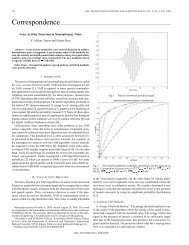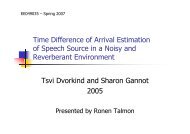Thesis (PDF) - Signal & Image Processing Lab
Thesis (PDF) - Signal & Image Processing Lab
Thesis (PDF) - Signal & Image Processing Lab
You also want an ePaper? Increase the reach of your titles
YUMPU automatically turns print PDFs into web optimized ePapers that Google loves.
5.1. THE COMPLETE INF-SEMILATTICE OF TREE REPRESENTATIONS 67<br />
In addition we must show that the infimum is unique. t1 ∧ t2 is created by a set<br />
intersection that is a known infimum, and then by operator Cr(·) that is a univalent<br />
operator. Any other graph, that is a subset of t1 ∩ t2 but is larger than t1 ∧ t2, could<br />
not be a tree, because it must contain a vertex not connected to the root vertex.<br />
Another question is about the infimum mapping function M. It is obtained in 2<br />
steps: a projections of source functions to t1 ∧ t2 and then infimum between them.<br />
Let’s assume that another infimum mapping function exists M3, such that at least<br />
one mapping - M(x) � M3(x) and M(x) �= M3(x). For this to be true, M3(x) must<br />
be a member of t1 ∧ t2 and smaller in tree sense then M1 and M2, but we recall that<br />
M is calculated from the tree infimum, therefore such M3 could not exist.<br />
Now, let us find out what the supremum of the tree representations is. First,<br />
notice that the union t1 ∪ t2 of two trees t1 and t2 is always connected, but one can<br />
not assure that it does not contain loops. Therefore, the union is not necessarily a<br />
tree. Worse, there does not necessarily exist a smallest tree that is larger than the<br />
union. For instance, if t1 = ({r, a, c}, {ra, ac}) and t2 = ({r, b, c}, {rb, bc}), then t1∪t2<br />
is equal to the graph ({r, a, b, c}, {ra, ac, rb, bc}), which is not a tree, and there does<br />
not exist a tree that contains it. Therefore, there does not exist a supremum of tree<br />
representations if the union of their trees is not a tree. Now, suppose that the union<br />
is a tree; let us focus on the mapping function. Now both M1(x) and M2(x) do belong<br />
to V (t1 ∪ t2), but their supremum in t1 ∪ t2 may not exist. In summary, we obtain<br />
the following.<br />
Proposition 3. The supremum T1 ∨ T2 of two tree representations T1 = (t1, M1) and<br />
T2 = (t2, M2) is given by:<br />
�<br />
⎧<br />
⎪⎨ (t1 ∪ t2, M1 �t1∪t2 M2), if t1 ∪ t2 is a tree, and<br />
T1 ∨ T2 =<br />
⎪⎩<br />
∃,<br />
M1 �t1∪t2 M2 exists,<br />
otherwise.<br />
(5.4)<br />
In conclusion, the set of tree representations together with the partial ordering de-<br />
△<br />
fined in (5.1) is a complete inf-semilattice. The least element is T0 = (({r}, {}), M0(x) ≡ r)).<br />
As indicated by the following proposition, calculations become much simpler when<br />
all tree presentations involved in an infimum or supremum operation have a common
















